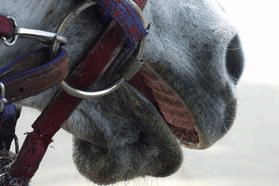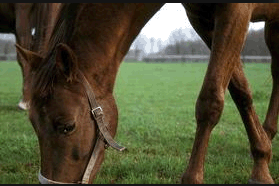Haylage explained
Summary
Haylage is fermented forage that ranges in nutritional value, with early-cut leafy haylage being more acidic and more nutrient-dense than the later cut more fibrous type. Early cut haylage is therefore more suited to horses with high energy demands. Once opened and exposed to air haylage has a limited shelf-life (aerobic spoilage) ranging from 5 days for early cut to only 3/2 for late cut haylage.
 Haylage can contain considerable levels of respirable dust, with pollen being particularly high in some types. Bacteria and mould content can also be high, so the best way to preserve nutrients, increase shelf-life and reduce microbial content is to steam it in a high-temperature Haygain steamer.
Haylage can contain considerable levels of respirable dust, with pollen being particularly high in some types. Bacteria and mould content can also be high, so the best way to preserve nutrients, increase shelf-life and reduce microbial content is to steam it in a high-temperature Haygain steamer.
Horses find post-steamed haylage very palatable and with the lower dust and microbial levels you can feed it for longer than freshly opened haylage.
Haylage is a popular and suitable forage for stabled horses, with 45% of UK owners (King, 2012) choosing haylage in preference to hay. As with hay it is the grass species it contains and the quality of the conservation process that influences the nutritional and hygienic quality of the forage. With haylage this is also determined by the time of cutting and nutritionists generally categorize haylage into early or late cut.
Early cut haylage
Often made from a single grass species such as Italian Rye Grass, this type of haylage has a low pH (high lactic acid content) and a low dry matter (DM) of 45-55%. It has a high leaf to stem ratio and is very nutrient dense. Once wrapped in plastic (6-8 layers ensures good anaerobic conditions) the sugars are fermented by bacteria into lactic acid which essentially pickles the grass so preserving it. A pleasant ‘acid-sweet’ smelling forage is produced in approximately 6 weeks.
Later haylage
Generally made from mixed lay or permanent pasture, so contains a variety of grass and legume species, this haylage has a high stem content so is more fibrous and drier at 55-70% DM. Later-cut haylage is closer to hay in nutrient content with a relatively low energy content of 7-8 MJ DE/kg and a CP content of 6-8%. This haylage is preserved simply by the exclusion of air, so it is very important that when conserving it 6-8- layers of plastic are used to ensure good anaerobic conditions.
Table 1. Significant difference between the nutrient and microbial content of early (June) and late cut (August) haylage and the effect on intake time and chews per minute when fed to stabled horses (adapted from Muller 2012)
|
|
Energy MJ DE/kg) |
Fibre g/kg |
DCP g/kg |
Mould (CFU / g log) |
Bacteria (CFU / g log) |
Intake time (min / kg) |
Chews / min |
|
June haylage |
12.4 |
522 |
91 |
1.26 |
1.48 |
29 |
2472 |
|
August Haylage |
7.7 |
647 |
44 |
2.04 |
4.30 |
36 |
2969 |
 Table 1 gives a clear indication of the characteristics of early and late cut haylage and the potential effects both have on diet nutrient status and horse health. Later cut haylage is much closer to hay in nutrient status so owners can feed more bulk encouraging foraging behaviour and more natural time budgets in stabled horses. The higher fibre content requires more chews / kg and as chewing promotes saliva production a fibrous forage such as late cut haylage or hay can help promote good gut health.
Table 1 gives a clear indication of the characteristics of early and late cut haylage and the potential effects both have on diet nutrient status and horse health. Later cut haylage is much closer to hay in nutrient status so owners can feed more bulk encouraging foraging behaviour and more natural time budgets in stabled horses. The higher fibre content requires more chews / kg and as chewing promotes saliva production a fibrous forage such as late cut haylage or hay can help promote good gut health.
Early-cut nutrient dense haylage is more suitable for performance horses with high energy demands. With a higher leaf:stem ratio it is more digestible than late-cut haylage so there is less indigestible ballast held in the gut. Feeding this type of haylage allows racehorse trainers to feed more forage with all the benefits that brings without their horses developing a fibre-belly.
Advantages and challenges when feeding haylage
With the problems farmers face in UK making good quality hay, haylage is often a safer bet as it can be made and wrapped within 2 days, generally resulting in cleaner nutritious forage. However, it is a mistake to believe that haylage is bacteria and mould free. In fact haylage can contain significant quantities of the fungi P. roqueforti.
Haylage is also NOT dust free as Table 2 shows. Haylage can contain high levels of pollen (Seguin et al., 2010) and recent work presented at WEAS 2017 has shown that horses with Equine Asthma are allergic to a range of pollens, bacteria and fungi (White et al., 2017).
Table 2. Airborne respirable dust in different types of forage
|
Forage |
Average respirable particles /litre air (+/-SD) |
|
Good hay |
63000 (+/- 30000) |
|
Late-cut haylage (87%DM) |
8800 (+/- 2500) |
|
Early-cut haylage (50%DM) |
4500 (+/- 1900) |
Source: (Vanderput et al. 1997)
In early cut haylage the production of lactic acid preserves the forage and if the pH is between 4 and 5 the shelf life in winter can be 5 days, dropping to 3 in summer. With late cut haylage less sugar is in the crop when cut so the lactobacilli bacteria have nothing to turn into lactic acid.
 This means the pH is higher at 5.6 to 6 so once opened, aerobic spoilage occurs sooner, dropping the shelf life to 2 days in the summer. Aerobic spoilage can include growth of the highly undesirable Clostridia botulinum species which occurs in high pH haylage and can be a particular risk in large round bales.
This means the pH is higher at 5.6 to 6 so once opened, aerobic spoilage occurs sooner, dropping the shelf life to 2 days in the summer. Aerobic spoilage can include growth of the highly undesirable Clostridia botulinum species which occurs in high pH haylage and can be a particular risk in large round bales.
Although early cut haylage is more nutrient dense and potentially ‘cleaner’, it is quite acidic. This poses challenges to dental health as detailed by Gere and Dixon, (2010) who found increased incidence of dental cares in horses fed haylage and concentrates compared with those fed hay and concentrates. The more nutrient dense haylage is also easy to over feed, so to avoid horses getting fat owners restrict access. This compromises natural foraging behaviour reducing the normal time budget of 16 hours per day feeding. Compromising feed intake and the natural trickle feeding behaviour can have negative effects on gut health.
Dealing with the challenges of feeding haylage
The quality of haylage can be improved by steaming and indeed the post-steamed forage is palatable, nutritious and clean. Dangerous bacteria and their by-products such as the C. botulinum toxin is inactivated at temp > 80oC (CDC, 1998) and as the high-temperature steamers made by Haygain reach temperatures in excess of 100oC, risk from botulism is significantly reduced.
It is important that haylage is steamed properly and at high temperatures. To do this you need to use a specifically designed high-temperature steamer such as the range made by Haygain. These steamers are designed to evenly distribute high temperature steam into all the forage and the specifically designed container allows high temperatures to be maintained for the required time (minimum of 10 minutes) to ensure microbe death, as detailed in Table 3.
Experiments have shown that steaming hay and haylage incompletely at lower temperatures (70-85oC) (Leggatt and Moore-Colyer, 2013) acts as an incubator causing an increase (up to 5-fold) in microbial content, which is highly undesirable. Interestingly, post-steamed haylage has lower bacteria and mould levels 4-days after steaming and is cleaner than freshly opened haylage. This is very useful as steaming haylage will increase shelf-life making haylage a suitable alternative to hay for the 1 or 2- horse owner. Big-bale haylage is more economical to buy and even adding the cost of steaming, it is still cheaper than buying small-bale haylage from the feed merchant. Cost small 20 kg bales = 30p/kg, big 300kg bale = 10p/kg + steaming at 16p/kg = 26p/kg.
Table 3 Total bacterial counts (TVC) and fungi in fresh haylage, haylage opened for 4 days, freshly steamed haylage and steamed haylage left open for 4 days
|
CFU |
Fresh |
Fresh + 4 days |
Steamed |
Steamed + 4 days |
s.e.d |
|
Fungi /g |
420 |
2786 |
12 |
128 |
|
|
Log fungi |
2.48c |
3.38d |
0.45a |
1.58b |
0.304 |
|
TVC/g |
41,600 |
114,000 |
10 |
304 |
|
|
Log TVC |
4.556c |
5.048c |
0.823a |
2.092b |
0.2701 |
abc Values in the same row not sharing letters differ significantly (P<0.05)
References
White S1,2, Moore-Colyer M1, Coüetil L3, Hannant D2, Richard E5, Marti E6 and Alcocer M2. (2017) Development of a Multiple Protein Extract Microarray for Profiling Allergen-Specific Immunoglobulin E in Horses with Severe Asthma. World Equine Airway Symposium. Openhagen, Denmark, July 2017.
King L (2012) A survey of forage feeding practices in UK. BSc thesis. Royal Agricultural College, Cirencester Glos. UK
Leggatt, P., and Moore-Colyer, M.J.S (2013) The effect of steam treatment on the bacteria, yeast and mould concentrations in haylage for horses. Proceedings of the British Society of Animal Science. Nottingham UK, April 2013
Seguin V, Lemauviel-Lavent S, Garon D, Bouchart V Gallard Y, et al (2010) Effect of agriculture and environmental factors on the hay characteristics involved in equine respiratory disease. Agric Ecosyst Environ 135: 206–215








